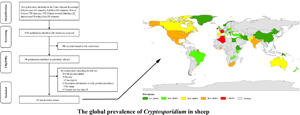Crossref Citations
This article has been cited by the following publications. This list is generated based on data provided by
Crossref.
Dărăbuș, Gheorghe
Lupu, Maria Alina
Mederle, Narcisa
Dărăbuș, Rodica Georgiana
Imre, Kalman
Mederle, Ovidiu
Imre, Mirela
Paduraru, Ana Alexandra
Morariu, Sorin
and
Olariu, Tudor Rares
2023.
Epidemiology of Cryptosporidium Infection in Romania: A Review.
Microorganisms,
Vol. 11,
Issue. 7,
p.
1793.
Holsback, Luciane
Marquez, Ellen de Souza
Silva, Marcelo Alves da
Porto, Petrônio Pinheiro
Garcia, João Luis
Martins, Felippe Danyel Cardoso
and
Seixas, Mércia de
2023.
Molecular characterization of Cryptosporidium in ruminants and observation of natural infection by Cryptosporidium andersoni in sheep from Paraná, Brazil.
Revista Brasileira de Parasitologia Veterinária,
Vol. 32,
Issue. 4,
Tako, Sivan
Fleiderovitz, Ludmila
Markovich, Michal Perry
Mazuz, Monica Leszkowicz
Behar, Adi
and
Yasur-Landau, Daniel
2023.
Cryptosporidium parvum gp60 subtypes in diarrheic lambs and goat kids from Israel.
Parasitology Research,
Vol. 122,
Issue. 9,
p.
2237.
Wang, Zhengrong
Peng, Xia
Bo, Xinwen
Zhang, Bowen
Zhang, Yanyan
Yu, Fuchang
Zhao, Aiyun
Zhang, Zhenjie
and
Qi, Meng
2023.
Molecular evaluation of Cryptosporidium spp. in sheep in southern Xinjiang, China.
Parasitology Research,
Vol. 122,
Issue. 12,
p.
2989.
Cheng, Cheng
Fan, Zhengrong
Cheng, Darong
and
Tao, Jianping
2024.
Prevalence of Cryptosporidium spp. in Sheep and Goats in Jiangsu, China.
Veterinary Sciences,
Vol. 11,
Issue. 4,
p.
144.
Zhao, Qianming
Qi, Meng
Jing, Bo
Jian, Fuchun
Gong, Pihong
Lu, Chenyang
Yan, Yaqun
Pei, Zhiyang
and
Ning, Changshen
2024.
Cryptosporidium spp. in large-scale sheep farms in China: prevalence and genetic diversity.
Scientific Reports,
Vol. 14,
Issue. 1,
Mirahadi, Seyed Nima
and
Moghaddasi, Kambiz
2024.
Cryptosporidiosis as One Health Issue in Iran: A Mini Review.
International Journal of Enteric Pathogens,
Vol. 12,
Issue. 1,
p.
47.
Li, Jiayu
Fan, Yingying
Li, Na
Guo, Yaqiong
Wang, Weijian
Feng, Kangli
He, Wei
Li, Falei
Huang, Jianbo
Xu, Yanhua
Xiao, Lihua
and
Feng, Yaoyu
2024.
Comparative genomics analysis reveals sequence characteristics potentially related to host preference in Cryptosporidium xiaoi.
International Journal for Parasitology,
Vol. 54,
Issue. 7,
p.
379.
Mwaba, Florence
Robertson, Lucy J.
Tembo, Rabecca
Zulu, Mildred
Ngalamika, Owen
Phiri, Andrew M.
and
Siwila, Joyce
2024.
Occurrence and factors associated with Cryptosporidium infection in livestock in three districts of Zambia.
Veterinary Parasitology: Regional Studies and Reports,
Vol. 52,
Issue. ,
p.
101057.
Aboelsoued, Dina
Toaleb, Nagwa I.
and
Abdel Megeed, Kadria N.
2025.
Coproantigen detection and molecular identification of Cryptosporidium species among newborn and adult farm animals.
AMB Express,
Vol. 15,
Issue. 1,
Tang, Tian-Cai
Jike, Ri-Hong
Zhu, Liang-Quan
Chen, Chao-Xi
and
Hao, Li-Li
2025.
Molecular Epidemiological Survey of Cryptosporidium in Ochotona curzoniae and Bos grunniens of Zoige County, Sichuan Province.
Animals,
Vol. 15,
Issue. 14,
p.
2140.
Peng, Xiaoxue
Wang, Xu
Jian, Jinhua
Zuo, Qingqiu
Liu, Hua
Wang, Yaxue
Su, Yaxin
Cao, Jianping
Jiang, Bin
and
Shen, Yujuan
2025.
Investigation of Cryptosporidium spp. and Enterocytozoon bieneusi in free-ranged livestock on the southeastern Qinghai–Xizang Plateau, China.
BMC Infectious Diseases,
Vol. 25,
Issue. 1,
Wei, Wei
Shi, Rui
Peng, Cheng
Li, Zhengyi
An, Lu
Wen, Jingyi
and
Wang, Rui
2025.
Meta-analysis and systematic review of the prevalence and risk factors of Cryptosporidium infection in ruminants in China.
International Journal for Parasitology,
Louro, Mariana
Ruano, Zita
Lozano, João
Györke, Adriana
Deak, Georgiana
da Fonseca, Isabel Pereira
and
Gomes, Jacinto
2025.
Molecular characterization of Cryptosporidium spp. and Giardia duodenalis infections and impact on growth performance of Churra Galega Mirandesa lambs.
Veterinary Parasitology,
Vol. 339,
Issue. ,
p.
110585.
Jones, Gethin
Matizanadzo, Joshua
Nelson, Andrew
Chalmers, Rachel M.
Thomas, Daniel Rhys
Williams, Stuart
Pinch, Maria
Sykes, Alison
Stiff, Rhianwen
and
Williams, Chris
2025.
A large Cryptosporidium parvum outbreak associated with a lamb-feeding event at a commercial farm in South Wales, March–April 2024: a retrospective cohort study.
Epidemiology and Infection,
Vol. 153,
Issue. ,
Hou, Meiru
Liu, Xuewei
Zhou, Lu
Zhou, Jiawang
Zhang, Yuxi
Ma, Tianshuai
Qiu, Hongyu
Wang, Chunren
and
Gao, Junfeng
2025.
Molecular characteristics and zoonotic potential of enteric protozoans in domestic small ruminants in Heilongjiang Province, Northeast China.
Food and Waterborne Parasitology,
Vol. 41,
Issue. ,
p.
e00296.
Kifleyohannes, Tsegabirhan
Skorpen, Elin
Hansen, Kine Rosnes
Stuen, Snorre
and
Robertson, Lucy J.
2025.
Cryptosporidium and Giardia infections of lambs in Southwest Norway: a longitudinal study.
Acta Veterinaria Scandinavica,
Vol. 67,
Issue. 1,
Adhikari, Roshan Babu
Adhikari Dhakal, Madhuri
Ghimire, Tirth Raj
and
Buch, Lipi
2025.
Prevalence of Coccidia and Other Intestinal Parasites in Indigenous Sheep (Ovis aries) in an Agricultural Area in Central Nepal.
Veterinary Medicine International,
Vol. 2025,
Issue. 1,
Vilela, Vinícius Longo Ribeiro
Feitosa, Thais Ferreira
Silva, Welitânia Inácia
and
Katzer, Frank
2025.
Cryptosporidium spp. in livestock in Brazil: An underestimated threat to animal and human health.
Current Research in Parasitology & Vector-Borne Diseases,
Vol. 8,
Issue. ,
p.
100312.



